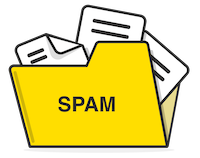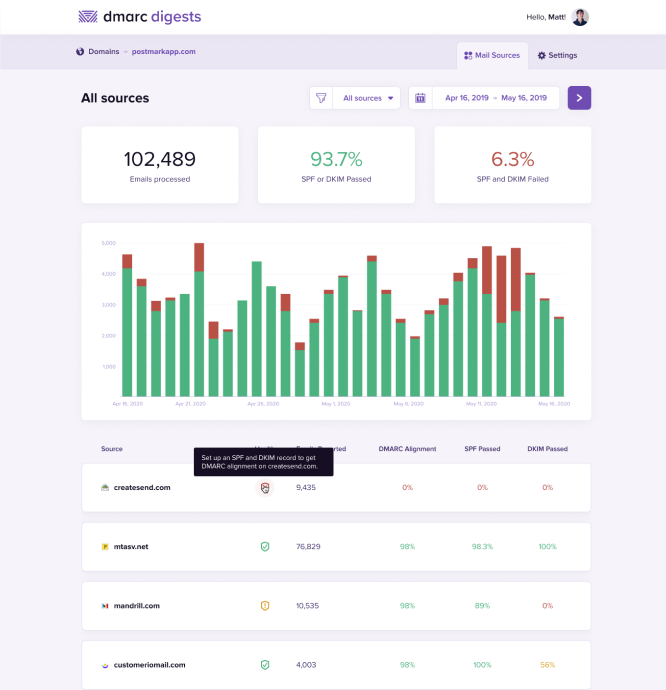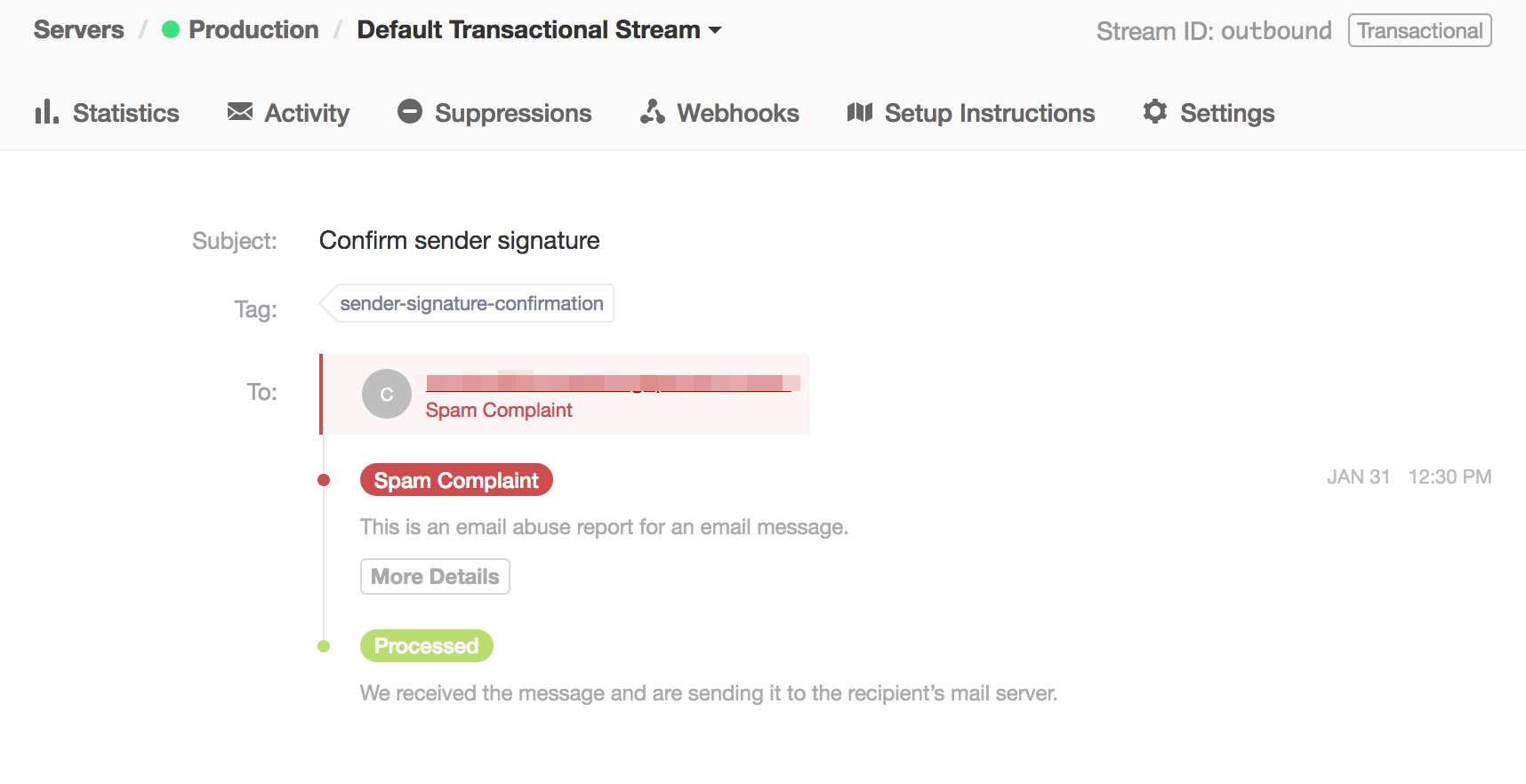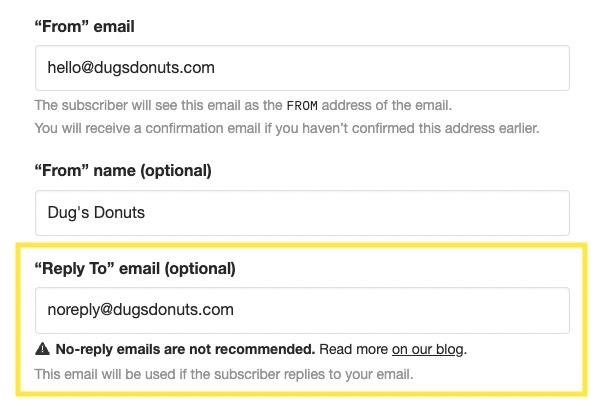13 reasons why your emails go into the spam folder (and what you can do about it)

It’s every email sender’s nightmare: your emails landed in the spam folder, not the inbox. But why do emails go to spam? In this guide, we’ll take a look at the most common reasons why legit emails might end up in spam and give you the tips you need to avoid that dreaded spam folder. Let’s dive right in.
What’s a spam filter and how does it work? #
Spam filters are programs designed to identify unsolicited or dangerous emails so that mailbox providers can stop those messages from reaching the inbox.
Spam filters use a broad range of criteria to analyze emails and to decide whether a message is spam:
- Some spam filters rely on scoring mechanisms: if an email’s spam score exceeds a certain threshold, the filter will mark it as spam
- Others use fingerprinting: an approach where spam filters keep a collection of known spam messages and then calculate how likely it is that an incoming email has a similar intent
- Advanced filtering mechanisms also use the power of machine learning to stay on top of spam.
It’s important to know that no two spam filters look alike. Gmail’s approach to spam scoring will be different from how Yahoo! Mail filters spam, so there’s a chance that your email might make it to the inbox with one provider and land in spam with the other.
All spam filters have one thing in common though: They’re set up to ensure that the inbox remains a clean, safe space that provides a great experience for the email recipient. So when an email—whether that’s personal messages or your brand’s newsletter or transactional email—goes to spam, you’ve done something that caused inbox providers to believe your email is unsolicited or even dangerous, or your email is simply replicating current trends in actual spam.
Stuck in email spam folder prison?
We made a comic about Ruthy Ribbit, an honest sender who finds herself in a pound full of nasty spammers. Will she manage to escape? Let's find out.
13 common reasons why emails land in the spam folder
#
So what are the factors that tip off spam filters? Mailbox providers will never give away how exactly their spam filters work. And why would they: Sharing their secret sauce would only make it easier for spammers, phishers, and other bad actors to work their way around spam filters.
But even if spam filter algorithms are a well-kept secret, we can learn from experience (and lots of troubleshooting.) For more than a decade, we’ve helped responsible senders troubleshoot why their emails got flagged as spam—and often it’s little errors or oversights in your email setup that tip-off spam filters and accidentally send legit email to spam. Let’s break them down one by one:
1. Your email isn’t properly authenticated #
It’s surprisingly easy for spammers and phishers to send emails that appear to come from your brand. But here’s the good news: There are a bunch of clever email authentication standards that you can put in place to prevent scammers from using your domain without your permission, and inbox providers rely on these standards to decide which emails are legit (and which are spam.)
So when an inbox provider’s spam filter spots an email that lacks authentication, that raises red flags. In fact, missing or improperly set up authentication is one of the most common reasons why legitimate email gets thrown into the spam folder. So when you’re troubleshooting spam issues, start here:
- Check if you set up SPF (Sender Policy Framework) correctly to provide a public list of sending IPs that are approved to send email from your domain. Here’s our full guide to SPF.
- Are your emails signed using DKIM (DomainKeys Identified Mail), an email security standard designed to make sure messages aren’t altered in transit? Our DKIM guide can give you more details about how it works to secure your email.
- Did you set up DMARC correctly? DMARC allows you to tell inbox providers to quarantine or reject emails that weren’t sent from a trusted source. If you don’t have it set up, scammers might send spam using your domain and hurt your domain reputation (and thus your deliverability). If you set up DMARC but it’s not configured correctly, you might accidentally send your legit email to the spam folder. To avoid these mistakes, learn how to set up DMARC with our ultimate DMARC guide.
Email authentication for humans
Fix authentication issues that prevent your email from reaching the inbox and see who’s sending using your domains with DMARC Digests.

2. Your sending IP has a bad reputation
#
The IP address you use to send your emails plays a crucial role for deliverability. Just like people build up a reputation over time (a good one if you behave like a good human, a bad one if you’re being a jerk) each IP address has a history that mailbox providers keep track of. For example, a track record of low spam complaints and bounce rates makes your sending IP more trustworthy, while a high number of complaints will put a dent in your IP’s credibility.
When you’re sending email via a shared IP, your IP reputation isn’t just built on your sending activity but on the combined sending habits of all senders on your IP. If you’re sharing your IP with spammers, your delivery will suffer. That doesn’t mean a shared IP is a bad thing though: If you’re associated with good senders, that can help boost your deliverability.
Your email landed in the Spam folder? Let’s see if a bad IP rep might be the culprit:
- Find out how good (or bad) your IP reputation is. Here’s a detailed guide for how to find your sending IP and what tools to use to check your IP reputation in just a few steps.
- Check if your IP is on a blocklist. MultiRBL is a popular service to quickly check for blocklistings.
- Are you seeing IP reputation issues? Reach out to your email service provider (ESP) to see if they can provide any more insights on what might be causing it and whether they’re already working on a fix.
If you’re working with a great ESP that only allows legit senders to use their platform (and ruthlessly weeds out spammers), IP reputation issues happen rarely or never. Do your sending IPs get blocked regularly? And does your ESP try to use these incidents to upsell you to a dedicated IP? Don’t fall for that trap. Both cases are a reason to look for a more trustworthy send service.
Speaking of which:
Looking for an email delivery service with great IP reputation? We’ve got you covered.
At Postmark, we take protecting our sending reputation seriously. Like really seriously. We vet every new customer and only support senders that follow email sending best practices. Period.
With this approach—and the help of our customers—we’ve built a pool of shared IPs with great reputation and top-notch deliverability, so that your emails make it to the inbox fast and reliably.
3. Your domain has a bad reputation #
Just like your sending IP, your domain has a history too—and spam filters are putting more and more weight on domain reputation when scoring your emails. That makes sense: You might be changing email service providers or will use different providers for different types of emails, all of which will use different IPs to send your emails. Your domain, though, is likely the same across providers, so looking at your domain reputation is a clever way to judge your trustworthiness as a sender.
To find out whether a low sending domain reputation could be the reason behind a spam folder placement…
- Check your domain reputation for senders who share the data with you. Gmail’s Postmaster tools, for example, will provide you with a detailed domain reputation score.
- See if your domain is on any blocklists as those have a significant impact on your domain reputation. MXToolBox or multiRBL.valli.org are two popular services to check multiple blocklists at once.
4. Your recipients marked your emails as spam #
If recipients mark an email as spam, that’s probably the most straightforward feedback that mailbox providers can consider when judging your emails—so it’s quite certain that users’ spam reports directly impact your deliverability. A high rate of users hitting the spam button will impact your reputation as a sender and cause future emails to land in the spam folder.
Here are a few things you can do to find out if user complaints might be the reason why your emails land in spam:
- Find out how many recipients are marking your emails as spam. If you’re using Google’s Postmaster tools, you can easily see the spam rate (that’s the percentage of emails marked as spam by users vs emails sent to the inbox for active users).

Google's Postmaster tools give helpful insights into spam complaint rates - Register for all available feedback loops, a service provided by some mailbox providers that shares insights about spam complaints generated by your campaigns. (If you’re using Postmark, we take care of that for you and provide spam complaint information right within Postmark.)
- If you see a spike in complaints, it’s time to investigate: Did a specific campaign cause these complaints? Who are the folks complaining? Did they all come from the same acquisition source?
- Stop sending emails to people who marked your emails as spam. If you continue to send to these folks, that could tank your reputation even further. If you’re using Postmark to send your email, we automatically suppress these recipients from future sends.

It looks like this subscriber marked an email as spam. We automatically add the subscriber to your suppression list so that they’ll no longer receive emails from you.
5. You don’t keep a clean email list #
Spammers and phishers typically don’t have a record of great list keeping. They shamelessly scrape (or steal) email addresses from somewhere, don’t care about invalid email addresses or bounces, and don’t care about engagement as long as a few clueless victims fall for their traps.
If inbox providers assume similar questionable list-building techniques for your brand, they’ll place you into the spam folder as well. That’s why a clean email list is the foundation of healthy email delivery. To keep your email list healthy, follow these tips:
- Only add opted-in subscribers to your list. Adding recipients to your mailing list who never agreed to receive emails from you is a common shortcut to grow your list, but it’s also a path that can lead straight to the spam folder.
- Never ever purchase or borrow email lists. Inbox providers find this practice shady, and they’ll punish senders who send to purchased lists accordingly. The same is true for scraping email addresses from the web. Just don’t do it.
- Remove recipients who unsubscribed and keep a close eye on your email bounces.
- If subscribers aren’t engaging with your emails, remove them from your email list. Inbox providers will notice if a large portion of your subscribers never open your emails or click any links—and it’s not a great look.
6. Your forms are being abused #
Form abuse is a surprisingly common reason for spam placements. Spambots sniff out unprotected forms and may submit invalid (or even valid!) email addresses, often causing a great influx of hard bounces and spam complaints that will quickly start to negatively impact your sending reputation. Don’t let that happen.
- Protect your forms with CAPTCHA or set up honeypot fields (i.e. fields that humans don’t see but spambots do) to prevent your forms from being abused.
- Put safeguards in place to detect spam, for example by blocking multiple submissions from the same IP address in a short period of time (those could be spam!)
7. You don’t have a working reply-to address set up #
When someone hits reply on your email, what’s the address the response will go to? As a sender, you can specify a reply-to address, and you should never use a “no-reply@example.com” address. Some spam filters and firewalls find "no-reply" email address handles to be spammy and will punish senders that use them with a higher spam score.
Plus, no-reply email addresses just aren’t a great experience for your recipients. Email is all about communication, isn’t it? But when you’re using a no-reply address, you’re denying your customers a chance to get in touch with you—and that might leave them frustrated.
There are cases where you might not want to receive emails back. In that scenario, we still suggest at least setting up a mailbox that actually works. You can browse it from time to time in case someone replied and needs help.
Do you have a working reply-to email set up? Be aware that the reputation of that address matters, too. We've seen messages thrown into spam because the reply-to looks suspicious or uses a freemail domain, a common phishing or spoofing tactic.

8. Your emails don’t have a plain-text version #
Spammers often don’t bother including a plain-text version of their HTML emails, so if you’re not including one in your emails either, some spam filters and firewalls might find it more likely that you’re a spammer, too.
So include a plain-text version with every email you send. This doesn’t just help prove to spam filters that you’re a legitimate sender but is also valuable to recipients who don't view the HTML version within their inbox. Plain-text emails also play a crucial role in making your emails more accessible because screen readers often rely on plain-text emails to read your messages.
Most email service providers make it easy to add a plain-text version when you create your email. If you’re using Postmark, you can easily toggle between the HTML and text view in the email editor, making it easy to add and edit the text version of your email.

9. You’re using link shorteners
#
It’s not uncommon for senders to use URL shorteners like bit.ly, as they’re an easy way to track clicks on links. But guess who also loves free URL shorteners? Spammers! That’s because link shorteners make it easy to hide malicious websites and hosted files from their victims.
If you’re using link shorteners in your emails, spam filters might flag your email as spam (or block your mail altogether, like we’ve seen happening in Gmail.) Don’t take that risk. If tracking links is important to you, see if your email provider offers link and engagement tracking.
10. You use open URLs #
Let's say you're a donut shop and you're sending a newsletter to encourage folks to check out your yummy treats. To add a website link to your HTML email, you have two options:
🍩 To check out this week's special treats, visit our website.
🍩 To check out this week's special treats, visit donutheaven-example.com.
Did you spot the difference?
Both emails send the reader to the donut shop's website, but the first one puts the hyperlink on the word "website" while the second one is using an open URL (also called raw link), that's a typed out and hyperlinked URL. Don't use that second option. In our years of troubleshooting deliverability issues, we found that the latter can cause your emails to be marked as spam.
Why? We can only assume that some spam filters found a pattern of spammers using open URLs, so better be safe and don’t use them in your emails.
11. You’re sending suspicious attachments #
Spammers love attachments: They might hide malware in ZIP files, sneak malicious macros into office files, or even use PDFs to get malicious code or phishing links in front of unsuspecting victims. So it’s no surprise that spam filters are taking an extra close look at emails that contain attachments.
If you can avoid it, don’t use attachments in your emails. If you’d like your recipients to download a file, you can make it available on your website and simply send your email readers there. That’s a few extra clicks, but it will make it more likely that your email makes it to the inbox.
12. Your content triggered spam filters #
For a long time, spam filters heavily relied on content filters. If you were using words or phrases that were commonly used by spammers, that made it more likely that your emails were placed in the spam folder as well.
As spam filters have become smarter and more sophisticated, they rely more and more on factors like your overall sender reputation. But that doesn’t mean that your words don’t matter anymore. Especially when dealing with smaller receivers, including corporate mailboxes or university inboxes, we continue to see a lot of content filtering rules. For example, we've even seen mail that includes 'curse words' get rejected by university filters for being inappropriate. 🙊
If you’re landing in spam and can’t find the cause in your sender reputation, authentication, or other factors listed above, take a look at your content:
- Remove any spammy words or phrases in your email copy, subject line, or preview text.
- Keep your copy concise and meaningful. If you don’t, content filters might mistakenly classify it as “spoetry”, that’s randomly generated copy that spammers use to trick receivers into thinking there’s real content in their emails. Spam filters have become better at spotting this gibberish—but they sometimes generate false positives.
13. You’re using sloppy HTML
#
Sloppy HTML tends to be characteristic of spammers—you know, spammers are busy spamming, so they don't have the time and resources to test their email code to make sure the content renders well.
While issues with your email rendering and broken HTML might not cause your emails to end up in spam right away, they can annoy your subscribers or they might find your message suspicious and hit the dreaded “mark as spam” button as a result.
To avoid spam caused by broken HTML…
- Use pre-built and tested email templates to ensure that your code is clean—especially when you’re not an expert in email HTML.
- Use email testing tools like Litmus to check the rendering of your emails across inboxes so you can catch errors in your HTML before you send.
Bonus! Link and image domain reputation and domain alignment
#
Many senders will focus on their own sending domain reputation, which is great. But don't forget about the reputation of the domains you use in your links and images! If those domains are having their own reputation issues, that reputation will carry over into your message as well, making it harder for the message to land in the inbox.
For example, say you host your email's images on an image sharing site. Those image hosting sites aren't necessarily built to host images for emails, so their domain's reputation is likely not great (many spammers and phishers will host their images using these free image hosting sites). Then when you send your email that includes images hosted on that free image hosting domain, receiving mail servers and spam filters will notice the domain and likely be more wary of the message.
The same goes with the domains used for your email's links. This is why it's important to use your own domain for your links and hosted images. You have control over your own domain's reputation, and in turn, are able to better control how receiving mail servers and firewalls treat your messages.
Another thing that can cause issues is the lack of alignment of your FROM domain with other domains in the body of your message (e.g. for any sort of link and/or image). For example:
- Logos and other images that are not hosted on your own domain (you send from donut@donutdonut.com, but in the body of your message you link to donut@donut.com)
- Social media links. You may wish to put social media icons in your email's footers, so it's important to note that if one of those social media domains are having their own sending reputation issues (which is very common), it can carry over into your message as well.
- Direct download links.
💡 To summarise, use caution when including links and images:
- that do not use your own domain
- hosted on domains different to your sending domain
💡 If you're seeing messages go to spam and you can't pinpoint the issue, try removing links and images from the message, or aligning the domains and try again. If that message then reaches the inbox, then you'll have found the culprit!
Get your emails delivered to the inbox, not the spam folder #
Email delivery is both an art and a science, but if you avoid the mistakes we mapped out in this guide, your emails shouldn't get caught in the spam folder.
Do you have any questions? We're here to help.


